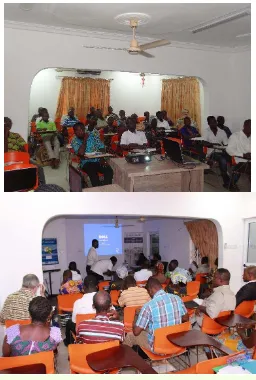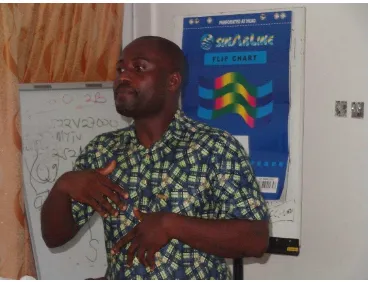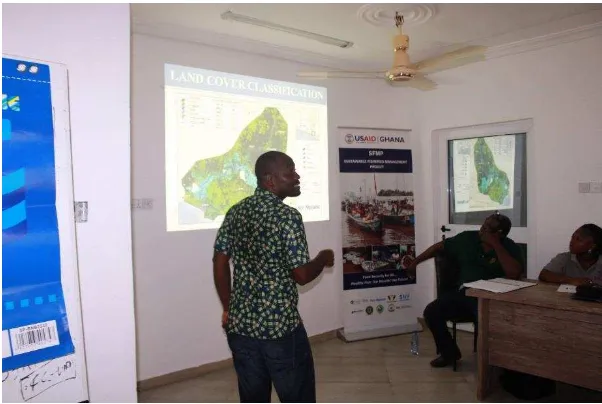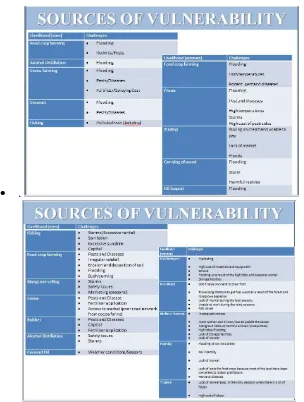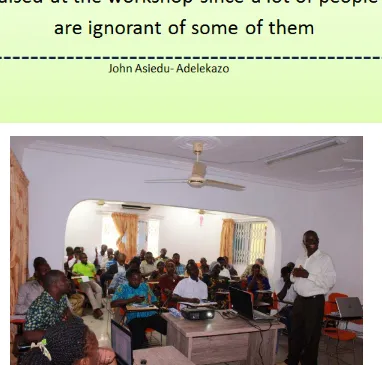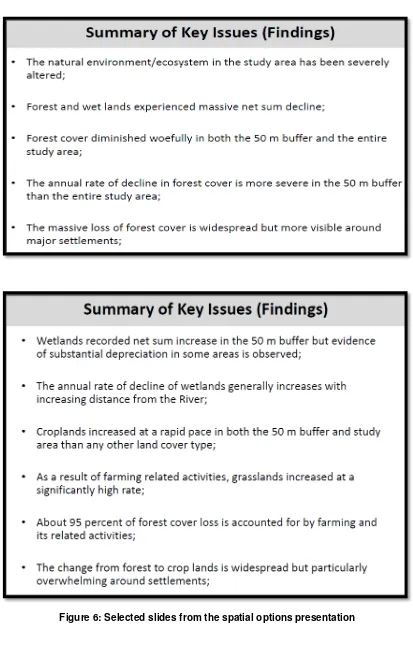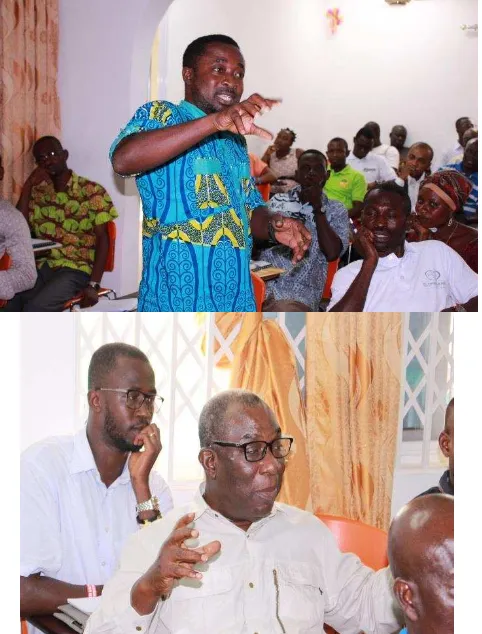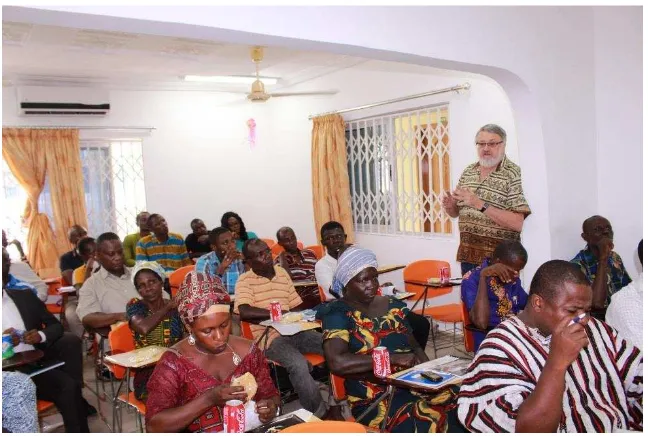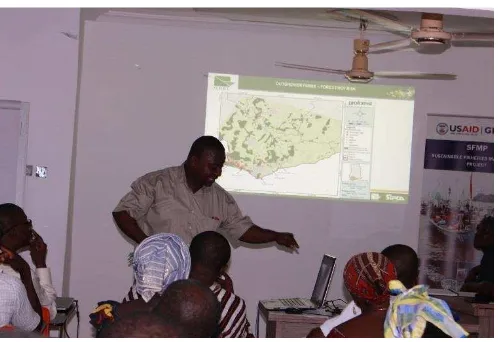SUSTAINABLE FISHERIES
MANAGEMENT PROJECT (SFMP)
ANKOBRA VULNERABILITY ASSESSMENT
INFORMATION DISSEMINATION WORKSHOP
REPORT
This publication is available electronically on the Coastal Resources Center’s website at
http://www.crc.uri.edu/projects_page/ghanasfmp/
For more information on the Ghana Sustainable Fisheries Management Project, contact:
USAID/Ghana Sustainable Fisheries Management Project Coastal Resources Center
Graduate School of Oceanography University of Rhode Island
220 South Ferry Rd.
Narragansett, RI 02882 USA
Tel: 401-874-6224 Fax: 401-874-6920 Email: [email protected]
Citation: Kankam S, Mensah C.J, Owusu A.A, Gormey B. (2016). Ankobra Vulnerability
Assessment Information Dissemination Workshop Report. The USAID/Ghana Sustainable Fisheries Management Project (SFMP), Hen Mpoano, Windy Ridge Extension, Takoradi. and Coastal Resources Center, Graduate School of
Oceanography, University of Rhode Island. Narragansett, RI. GH2014_ACT051_HM 20 pp.
Authority/Disclaimer:
Prepared for USAID/Ghana under Cooperative Agreement (AID-641-A-15-00001), awarded on October 22, 2014 to the University of Rhode Island, and entitled the USAID/Ghana Sustainable Fisheries Management Project (SFMP).
This document is made possible by the support of the American People through the United States Agency for International Development (USAID). The views expressed and opinions contained in this report are those of the SFMP team and are not intended as statements of policy of either USAID or the cooperating organizations. As such, the contents of this report are the sole responsibility of the SFMP team and do not necessarily reflect the views of USAID or the United States Government.
Detailed Partner Contact Information:
USAID/Ghana Sustainable Fisheries Management Project (SFMP) 10 Obodai St., Mempeasem, East Legon, Accra, Ghana
Telephone: +233 0302 542497 Fax: +233 0302 542498
Maurice Knight Chief of Party [email protected]
Kofi Agbogah Senior Fisheries Advisor [email protected] Nii Odenkey Abbey Communications Officer [email protected]
Bakari Nyari Monitoring and Evaluation Specialist [email protected] Brian Crawford Project Manager, CRC [email protected]
Justice Odoi USAID Administrative Officer Representative [email protected]
Kofi.Agbogah
SNV Netherlands Development Oganization #161, 10 Maseru Road,
E. Legon, Accra, Ghana 233 30 701 2440 Donkris Mevuta Kyei Yamoah
[email protected] Friends of the Nation Parks and Gardens Adiembra-Sekondi, Ghana 233 312 046 180
Peter Owusu Donkor Spatial Solutions
[email protected] #3 Third Nautical Close,
Nungua, Accra, Ghana
Darkuman Junction, Kaneshie Odokor Highway
Accra, Ghana 233 302 315894 Gifty Asmah
[email protected] Daasgift Quality Foundation
Headmaster residence, Sekondi College Sekondi, Western Region, Ghana 233 243 326 178
For additional information on partner activities:
CRC/URI: http://www.crc.uri.edu
CEWEFIA: http://cewefia.weebly.com/
DAA: http://womenthrive.org/development-action-association-daa Daasgift:
ACRONYMS
CRC Coastal Resources Center
CSLP Coastal Sustainable Landscape Project EDA Ellembelle District Assembly
EPA Environmental Protection Agency FoN Friends of the Nation
GIS Geographic Information System GREL Ghana Rubber Estates Limited NEMA Nzema East Municipal Assembly
SFMP Sustainable Fisheries Management Program TCPD Town and Country Planning Department URI University of Rhode Island
USA United States of America
TABLE OF CONTENTS
ACRONYMS ... iii
TABLE OF CONTENTS ... iv
LIST OF FIGURES ... iv
INTRODUCTION ... 1
OBJECTIVES ... 1
WELCOME ADDRESS AND BACKGROUND TO THE SFMP BY MR. STEPHEN KANKAM... 3
PRESENTATIONS AND DISCUSSIONS ... 3
Climate Livelihood Vulnerability Assessment by Stephen Kankan ... 3
Key Messages ... 4
Ankobra Estuarine From Spatial Analytical Perspective by Peter Donkor ... 5
Key Messages ... 6
QUESTIONS, SUGGESTIONS, CONTRIBUTIONS ... 7
REMARKS BY PARTNERS ... 8
CSLP ... 8
DAASGIFT ... 9
GREL ... 9
Way forward ... 10
Annex 1: Workshop participant list ... 12
LIST OF FIGURES
Figure 1: A cross-section of participants at the workshop ... 2Figure 2: Stephen Kankam giving welcome address ... 3
Figure 3: Stephen Kankam presenting on the findings of the Vulnerability assessment to stakeholders... 4
Figure 4: Selected slides showing sources of vulnerability for livelihood for the communities ... 5
Figure 5: Mr. Peter Donkor presenting on findings of the spatial options assessment ... 6
Figure 6: Selected slides from the spatial options presentation ... 7
Figure 7: Participants asking questions and making contributions after the presentations. ... 8
Figure 8: Mr. Steve Dennison Director CSLP ... 9
Figure 9: Stephen Swanzy Daasgift Quality Foundation ... 9
INTRODUCTION
The Sustainable Fisheries Management Project (SFMP) is a five year effort to revamp the decline small pelagic Fisheries. As part of activities being implemented under the SFMP, HM is working at the Ankobra River Estuarine and Mangrove ecosystem to integrate community fisheries management and resilience plans. During SFMP Fiscal year one a vulnerability assessment was conducted for five (5) communities (Sawoma, Adelekazo, Eziome, Eshiem and Kukuaveli within the Ankobra River Ecosystem to identify climate and non-climate threats impacting livelihoods and well -being of the estuarine communities.
A validation workshop was conducted on the 15th of September 2015 at Axim, Western Region of Ghana to validate findings of the vulnerability assessment and also solicit further stakeholder input and possible collaboration with other actors within those areas to build resilient livelihoods and ecosystem.
This information-sharing workshop was held at Esiama, in the Ellembelle district in Western Region of Ghana as a direct follow-up on the vulnerability assessment validation workshop conducted for the five estuarine communities of the Ankobra Estuary catchment area. The purpose of workshop was to share the assessments (spatial options analysis, Ankobra climate vulnerability assessment) and relevant information on the Ankobra area with key
stakeholders and foster a collaborative approach to finding lasting solutions to identified issues.
There were 36 participants in attendance, with representatives from the 5 Ankobra estuarine communities, Officers from Nzema East Municipal Assembly (NEMA) and Ellembelle District Assembly (EDA) and the Regional Town and Country Planning Department (TCPD). Also in attendance were representatives of GREL, EPA, Fisheries Commission, and the Water Resources Commission. Representatives of partner organizations (Spatial Solutions, FON and Daasgift) and the Chief of Party of the Coastal Sustainable Landscape project participated in the workshop, (See Annex for detailed list of participants).
OBJECTIVES
The objectives of the workshop were to
Share key findings of the Ankobra assessments with relevant stakeholders.
WELCOME ADDRESS AND BACKGROUND TO THE SFMP BY MR.
STEPHEN KANKAM
Stephen Kankam the activity manager of SFMP welcomed participants to the workshop. In his welcome statement Mr. Kankam reiterated the commitment to have an effective discourse with all relevant stakeholders in finding a common solution to some of the challenges being faced in our various communities.
Figure 2: Stephen Kankam giving welcome address
He went on further to introduce the SFMP and put the Ankobra estuarine assessments in perspective. He acknowledged the different partners the project is working with from the Western, Central and Greater Accra with a common goal to revamp the decline in fishery. He stated that, though the project is a fishery project, there is also a focus on two key estuarine environments namely; the Pra and Ankobra estuaries- because of the critical role they play in fishery, serving as a nursery ground for some key fish species particularly the demersal species. The project is not just working with the Ministry of Fisheries and Aquaculture development, but also working with District Assemblies and Town and Country planning Department to see how those areas can be planned out to respond not only to the decline in fish stocks but also the issues of climate change and other stressors or drivers of change within those estuarine environment
PRESENTATIONS AND DISCUSSIONS
Two presentations based on the assessments (the Ankobra vulnerability and the spatial options assessments) were delivered by Staff of Hen Mpoano and Spatial solutions. Climate Livelihood Vulnerability Assessment by Stephen Kankan
related activities within the Ankobra ecosystem contributes to one of the four intermediate results of the project- Implementation of Applied management initiative
He also mentioned that the project had a national focus, looking at a sardinella management plan. Since these species are migratory the project’s focus is on the entire coast and not limited to the estuary. He indicated that, there is already a national Fisheries Management plan that looks at all the species. What the SFMP wants to contribute to is a subset of that Management plan which is the Sardinella management plan.
Figure 3: Stephen Kankam presenting on the findings of the Vulnerability assessment to stakeholders
Key Messages
The Assessment was done for the lower Ankobra Catchment basin not only to understand climate drivers but also some non-climate stressors as well.
The assessment was a strategy to structure the planning and management approach foreseen for the Ankobra Estuary.
A livelihood vulnerability approach was taken because of the focus of the project and also how the livelihood of those people fringing the estuary is dependent on the resource and the importance of managing those livelihood and the resources of that area.
.
Figure 4: Selected slides showing sources of vulnerability for livelihood for the communities
Ankobra Estuarine From Spatial Analytical Perspective by Peter Donkor
Mr. Peter Donkor presented on the Spatial Options Analysis aspect of the Assessment. In his presentation, he mentioned that, the Ankobra River Estuarine and the surrounding
communities have issues to deal with and one key thing to do in order to understand these issues is the type of land use/activities happening in those areas. He indicated that a spatial analysis was necessary to identify the different land uses (man-made and naturally occurring) patterns happening within the Ankobra Catchment area. He emphasized that some of the land use changes detected from the analysis, were as a result of population increase within the area. Although some of the activities happening currently were already ongoing in the past, due to population increase the effect of these activities has intensified.
Figure 5: Mr. Peter Donkor presenting on findings of the spatial options assessment
Key Messages
For planning regulations, there is the need for a buffer zone (riparian zone) along every water body to protect the water. For a bigger river like the Ankobra we need to have a buffer of 50 meters on either side.
The number of settlements within these areas are very small but the impact of their activities are enormous
Figure 6: Selected slides from the spatial options presentation
QUESTIONS, SUGGESTIONS, CONTRIBUTIONS
People moved to these communities because of the availability of fish within the
Ankobra area, but due to the level of pollution of the water body they don’t get enough
fish to catch
Local authorities were managing their natural resources and were doing a good job until the democratic system of governance came and a lot of policies developed and the resources are deteriorating
The issue is both government and the behavior of the people
Are community members aware of existing buffers and who manages it?
Some education has gone in some communities on the buffer zone, but the effort is still inadequate
People don’t regard nature any longer when you go to our big cities you don’t find lots
of green areas.
Most of the issues discussed seemed to be coming from the community members living in those areas. They may be doing it in the past but due to population increase the effects has intensified with increased impact
GREL, in going forward, should link the impact of their activities to food security
Figure 7: Participants asking questions and making contributions after the presentations.
REMARKS BY PARTNERS
CSLP
Figure 8: Mr. Steve Dennison Director CSLP
DAASGIFT
The representative of DAASGIFT Quality Foundation mentioned some of the work they are doing and their engagement with the women groups and the youth at Sanwoma. They are engaged in education and sensitization of these groups on sustainable fisheries. He reiterated the need for a more intensified education to change some of the perception they have towards fisheries. He indicated that most of these folks they are working with still believe fish gets
rained down from the sky and can’t get depleted since they always come during the raining
season.
Figure 9: Stephen Swanzy Daasgift Quality Foundation
GREL
Figure 10: Mr. Paa Nyarko Aidoo presenting on process involved in rubber plantation
WAY FORWARD
The workshop was successful in bringing key stakeholders together to discuss in detail what should be the next step to build support for the joint district management of the shared natural resources along the Ankobra River.
Some of the things suggested in moving forward include: Increased awareness of the buffer zone
Roles and responsibilities should be assigned to the various institutions Integrative and interactive approach to Co-management
Education (Representatives from media houses, School Environmental Clubs) Training on adaptation practices
Representation of villages in committee
Water Resources Forestry Commission
Environmental Protection Agency
District Assembly (Planning Dept. and Environmental Unit ) Traditional Authorities
Stool Lands
Mineral Commission Fisheries Commission
Five Estuarine Communities of the Ankobra Catchment area
A small working group committee of 11 was formed at the workshop. This group will begin a consultation process to nominate representatives to be part of the committee and also solicit for support in forming the bigger committee.
The membership of the working group is as follows; Traditional Authority
Planning Officers (2)
Water Resources Commission 5 community Representatives
EPA
ANNEX 1: WORKSHOP PARTICIPANT LIST
GHANA SUSTAINABLE FISHERIES PROJECT-HM
PARTICIPANTS ROSTER INFORMATION
Required in English
Please Print
---
Title of Course: ANKOBRA ESTUARINE ASSESSMENTS DISSEMINATION WORKSHOP
Activity: WORKSHOP
Date: 19TH JANUARY 2016
Length of Course: Less than three days Three days or longer
First Name Surname Organization/Commu
Tu-agyan ii
Gwira traditional
council
X
First Name Surname Organization/Commu nity
Sex
Do you wish to receive messages on
SFMP?
Signature/To mb Print
M F Y N
Rosemary
Ackah
Sanwoma
XStephen
Dennison
CSLP
x xMawuli
Lumor
WRC-ankobra basin
office
X x
